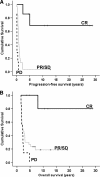Long-term survival in patients with metastatic melanoma treated with DTIC or temozolomide
- PMID: 20538743
- PMCID: PMC3228011
- DOI: 10.1634/theoncologist.2009-0237
Long-term survival in patients with metastatic melanoma treated with DTIC or temozolomide
Abstract
Background: Patients with metastatic melanoma typically have a poor outcome; however, a small proportion of patients achieve long-term survival (LTS). It is unclear how often LTS is related to sensitivity to chemotherapy.
Methods: All patients with metastatic melanoma treated with either dacarbazine (DTIC) or temozolomide (TMZ) at the British Columbia Cancer Agency (BCCA) from January 1, 1988 to February 1, 2006 were identified through the BCCA pharmacy electronic database, which was then linked to the surveillance and outcomes unit to identify patients with LTS, defined as survival > or =18 months following chemotherapy.
Results: In total, 397 patients were treated with either DTIC (n = 349) or TMZ (n = 48) and 43 patients (10.8%) were identified with LTS. Two additional patients with LTS were added prior to 1988 for a total of 45 patients. The 5-year overall and progression-free survival rates for patients with LTS were 33% and 16%, respectively. In total, 16% had a complete response (CR) to chemotherapy, which was the only factor identified that correlated with survival in the multivariate analysis. However, most patients with LTS had an incomplete response to chemotherapy.
Conclusions: LTS occurs in select patients who achieve a CR to chemotherapy. However, this occurs in only a minority of patients and, in most cases, the longer survival is likely the result of indolent disease biology or host factors.
Conflict of interest statement
The content of this article has been reviewed by independent peer reviewers to ensure that it is balanced, objective, and free from commercial bias. No financial relationships relevant to the content of this article have been disclosed by the authors or independent peer reviewers.
Figures



References
-
- Gogas HJ, Kirkwood JM, Sondak VK. Chemotherapy for metastatic melanoma: Time for a change? Cancer. 2007;109:455–464. - PubMed
-
- Hill GJ, 2nd, Krementz ET, Hill HZ. Dimethyl triazeno imidazole carboxamide and combination therapy for melanoma. IV. Late results after complete response to chemotherapy (Central Oncology Group protocols 7130, 7131, and 7131A) Cancer. 1984;53:1299–1305. - PubMed
-
- Bedikian AY, Johnson MM, Warneke CL, et al. Prognostic factors that determine the long-term survival of patients with unresectable metastatic melanoma. Cancer Invest. 2008;26:624–633. - PubMed
-
- Brand CU, Ellwanger U, Stroebel W, et al. Prolonged survival of 2 years or longer for patients with disseminated melanoma. An analysis of related prognostic factors. Cancer. 1997;79:2345–2353. - PubMed
-
- Balch CM, Soong SJ, Murad TM, et al. A multifactorial analysis of melanoma. IV. Prognostic factors in 200 melanoma patients with distant metastases (stage III) J Clin Oncol. 1983;1:126–134. - PubMed
MeSH terms
Substances
LinkOut - more resources
Full Text Sources
Medical

